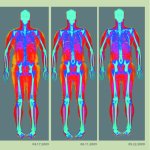Special report: Bone Densitometry market on the mend
May 09, 2011
From the May 2011 issue of HealthCare Business News magazine
Government promotion of bone density testing has been gaining strength as a result of U.S. Food and Drug Administration-approved drug treatments for osteoporosis and recommendations by the surgeon general.
More recently, the U.S. Preventative Services Task Force has called to expand the population of screened women by recommending the screening of high-risk women under 65 – those who have as high a risk of fracture as women 65 and
older.


New recommendations for women under 65
According to a January release from the USPSTF, approximately 12 million Americans 50 years and older are expected to have osteoporosis by 2012. In addition, one-half of all postmenopausal women are expected to suffer an osteoporosis-related fracture during their lifetime.
Postmenopausal women under the age of 65 may be in just as much danger of a fracture if they are low on the body-mass index, smoke, have a high-alcohol intake or have a family history of fracture. Physicians now have a series of tools to calculate fracture risk, including FRAX, an algorithm developed by the World Health Organization that can predict a patient’s potential risk of fracture.
Dr. Ethel Siris, the immediate past president of the National Osteoporosis Foundation and director of the Toni Stabile Osteoporosis Center at Columbia University Medical Center in New York, is encouraged by the new recommendations for osteoporosis screening for at-risk women between 50 to 65 years of age.
“Their statement clearly legitimizes, with public health policy, the value of doing bone density testing in women who are at risk of fractures, whether it’s 65 and up or younger than 65 with risk factors,” says Siris. “One great value is that there is scientific review involved, which makes a more solid public health recommendation.”
Patient access further threatened
After Medicare reimbursement in the non-hospital setting was reduced, physician and patient advocacy groups including the ISCD and NOF rallied to reinstate a higher reimbursement rate.
“The issue of reimbursement is a serious one when juxtaposed with America’s poor access to bone density testing,” says Siris. “A new bone densitometer might cost a private or group practice $125,000, and at the height of CMS’s reimbursement lows, the reimbursements were not even covering the cost of the equipment.”
Government promotion of bone density testing has been gaining strength as a result of U.S. Food and Drug Administration-approved drug treatments for osteoporosis and recommendations by the surgeon general.
More recently, the U.S. Preventative Services Task Force has called to expand the population of screened women by recommending the screening of high-risk women under 65 – those who have as high a risk of fracture as women 65 and
older.
We repair MRI Coils, RF amplifiers, Gradient Amplifiers and Injectors.
MIT labs, experts in Multi-Vendor component level repair of: MRI Coils, RF amplifiers, Gradient Amplifiers Contrast Media Injectors. System repairs, sub-assembly repairs, component level repairs, refurbish/calibrate. info@mitlabsusa.com/+1 (305) 470-8013

New recommendations for women under 65
According to a January release from the USPSTF, approximately 12 million Americans 50 years and older are expected to have osteoporosis by 2012. In addition, one-half of all postmenopausal women are expected to suffer an osteoporosis-related fracture during their lifetime.
Postmenopausal women under the age of 65 may be in just as much danger of a fracture if they are low on the body-mass index, smoke, have a high-alcohol intake or have a family history of fracture. Physicians now have a series of tools to calculate fracture risk, including FRAX, an algorithm developed by the World Health Organization that can predict a patient’s potential risk of fracture.
Dr. Ethel Siris, the immediate past president of the National Osteoporosis Foundation and director of the Toni Stabile Osteoporosis Center at Columbia University Medical Center in New York, is encouraged by the new recommendations for osteoporosis screening for at-risk women between 50 to 65 years of age.
“Their statement clearly legitimizes, with public health policy, the value of doing bone density testing in women who are at risk of fractures, whether it’s 65 and up or younger than 65 with risk factors,” says Siris. “One great value is that there is scientific review involved, which makes a more solid public health recommendation.”
Patient access further threatened
After Medicare reimbursement in the non-hospital setting was reduced, physician and patient advocacy groups including the ISCD and NOF rallied to reinstate a higher reimbursement rate.
“The issue of reimbursement is a serious one when juxtaposed with America’s poor access to bone density testing,” says Siris. “A new bone densitometer might cost a private or group practice $125,000, and at the height of CMS’s reimbursement lows, the reimbursements were not even covering the cost of the equipment.”
You Must Be Logged In To Post A CommentRegisterRegistration is Free and Easy. Enjoy the benefits of The World's Leading New & Used Medical Equipment Marketplace. Register Now! |
|











